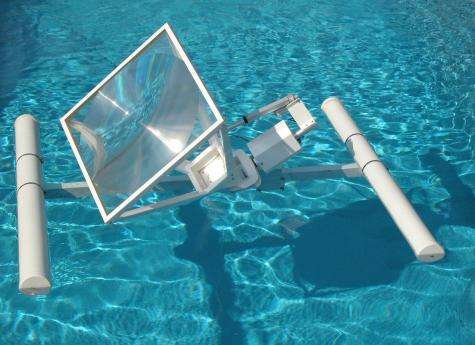March 30, 2011 report
India signs on to floating solar energy power plant (w/ video)

(PhysOrg.com) -- In a country where nearly 40 percent of households have no electricity, any new advancement that will help bring power to the world’s second most populous nation, must be met with celebration and open arms.
Tata Power, subsidiary, of Indian giant Tata Group, has announced a partnership with Sunengy, an Australian company that specializes in Liquid Solar Array (LSA) technology, to build a floating solar array power plant in an as yet to be announced location somewhere in India.
The power plant is comprised of a rectangular grid upon which sit rows and columns of movable lightweight plastic lenses that focus incoming sunlight onto a small panel of photovoltaic cells. The lenses can be programmed to follow the sun in tandem as it moves across the sky, thus taking full advantage of available sunlight. They lenses can also be made to slide beneath the waves when bad weather threatens, thus preventing damage from high winds or hail. The grid is in essence a floating raft that can be anchored in place wherever there is available water.
Phil Connor, Executive Director and Chief Technology Officer of Sunengy, and also the inventor of the LSA, has said that he believes India is the best possible proving ground for his LSA technology and feels that his floating power plants might best be suited to placement just behind hydro-electric dams, where he suggests they might serve as “giant batteries,” effectively doubling capacity at a site while taking up no additional land space.
In addition to the benefit of not having to give up land to provide space for the LSA, its installation and maintenance costs are expected to be far lower than for traditional power plants, including land based solar farms. This is due to the absence of high strength structures to support the solar arrays, and to the reduced amount of materials in each component, i.e. less silicone because the cells can be water cooled on a continuous basis. The initial plant project in India is expected to cost in the neighborhood of $1 million, with a projected start date of August of 2011.

The only dark cloud on this otherwise bright project is the possibility of damage due to cyclones if water levels rise to the extent that an entire plant could be ripped from its moorings; though Sunengy claims their components are cyclone proof; as yet, that claim has not been tested.
More information: sunengy.com/
© 2010 PhysOrg.com


















